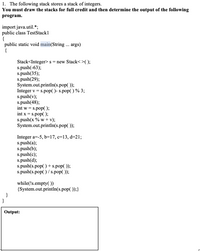
Computer Networking: A Top-Down Approach (7th Edition)
7th Edition
ISBN: 9780133594140
Author: James Kurose, Keith Ross
Publisher: PEARSON
expand_more
expand_more
format_list_bulleted
Question
java
dont use others answers please
follow thw istructions on the photo
Thank you!!!

Transcribed Image Text:# Program Explanation and Output for Educational Website
## Task:
The following program works with a stack of integers. The task is to simulate the operations performed on the stack and determine the output produced by the program.
## Program Code:
```java
import java.util.*;
public class TestStack1
{
public static void main(String ... args)
{
Stack<Integer> s = new Stack<>();
s.push(-63);
s.push(35);
s.push(29);
System.out.println(s.pop());
Integer v = s.pop() - s.pop() % 3;
s.push(v);
s.push(48);
int w = s.pop();
int x = s.pop();
s.push(x % w + v);
System.out.println(s.pop());
Integer a=-5, b=17, c=13, d=21;
s.push(a);
s.push(b);
s.push(c);
s.push(d);
s.push(s.pop() + s.pop());
s.push(s.pop() / s.pop());
while(!s.empty())
{
System.out.println(s.pop());
}
}
}
```
## Explanation of the Program:
1. **Stack Initialization and Operations:**
- A stack `s` is created and integers are pushed in the following order: `-63`, `35`, `29`.
- The program pops and prints the top element of the stack: `29`.
- The value `v` is calculated using the next two elements of the stack: `35 - (-63 % 3)` which results in `38`.
2. **Further Stack Manipulations:**
- The value `38` is pushed onto the stack followed by the integer `48`.
- The top value (`48`) is popped and stored in `w`, followed by popping the next value (`38`) into `x`.
- The expression `x % w + v` is evaluated, resulting in `38`, which is then pushed back onto the stack.
- The program pops and prints the top element: `38`.
3. **Second Set of Stack Operations:**
- New integers are pushed onto the stack: `-5`, `17`, `13`, `21`.
- The top two numbers are popped (`21` and `13`), their sum `34` is pushed onto the stack.
- A division operation is executed
Expert Solution
This question has been solved!
Explore an expertly crafted, step-by-step solution for a thorough understanding of key concepts.
This is a popular solution
Trending nowThis is a popular solution!
Step by stepSolved in 2 steps with 4 images

Knowledge Booster
Similar questions
- Strict Warning ⚠️ don't you dare useany AI tool otherwise I'll report your accountarrow_forwardQuestion 1 In Java, which of the following are characteristics of an int (select two) a. You can use operators on it b. It holds the actual value of a number O c. It holds a reference to a number Od. It is a class. Strings in Java are really annoying, which of the following statements about them are true (and no we';re not giving a hint about how many answers are correct for this one!): a. Strings can be manipulated with the + operator b. Strings can use the operator to remove the content of one string from another c. Strings are built into Java at a fundamental level. d. Strings store their text as an array of characters. Imagine that we have a class called Car. Which three of the following are most likely to be attributes of it: a. paintColour O b. multistoreyCarpark O c. insuranceStatus O d. engine e. roadarrow_forward6:40 Back Assignment Details Object Oriented Programming Student first_name : string last_name: string id: int gpa : double major: string + set(): void + print(): void Sample Run (User input in bold): Student Information Database First Name: Elaine Last Name: Benes ID: 1961 GPA: 4.0 Major: French_Literature First Name: George Last Name: Costanza ◄ Previous Submit Assignment Dashboard Calendar 7 To Do C Notifications LTE 264 Next ► Inboxarrow_forward
arrow_back_ios
arrow_forward_ios
Recommended textbooks for you
 Computer Networking: A Top-Down Approach (7th Edi...Computer EngineeringISBN:9780133594140Author:James Kurose, Keith RossPublisher:PEARSON
Computer Networking: A Top-Down Approach (7th Edi...Computer EngineeringISBN:9780133594140Author:James Kurose, Keith RossPublisher:PEARSON Computer Organization and Design MIPS Edition, Fi...Computer EngineeringISBN:9780124077263Author:David A. Patterson, John L. HennessyPublisher:Elsevier Science
Computer Organization and Design MIPS Edition, Fi...Computer EngineeringISBN:9780124077263Author:David A. Patterson, John L. HennessyPublisher:Elsevier Science Network+ Guide to Networks (MindTap Course List)Computer EngineeringISBN:9781337569330Author:Jill West, Tamara Dean, Jean AndrewsPublisher:Cengage Learning
Network+ Guide to Networks (MindTap Course List)Computer EngineeringISBN:9781337569330Author:Jill West, Tamara Dean, Jean AndrewsPublisher:Cengage Learning Concepts of Database ManagementComputer EngineeringISBN:9781337093422Author:Joy L. Starks, Philip J. Pratt, Mary Z. LastPublisher:Cengage Learning
Concepts of Database ManagementComputer EngineeringISBN:9781337093422Author:Joy L. Starks, Philip J. Pratt, Mary Z. LastPublisher:Cengage Learning Prelude to ProgrammingComputer EngineeringISBN:9780133750423Author:VENIT, StewartPublisher:Pearson Education
Prelude to ProgrammingComputer EngineeringISBN:9780133750423Author:VENIT, StewartPublisher:Pearson Education Sc Business Data Communications and Networking, T...Computer EngineeringISBN:9781119368830Author:FITZGERALDPublisher:WILEY
Sc Business Data Communications and Networking, T...Computer EngineeringISBN:9781119368830Author:FITZGERALDPublisher:WILEY

Computer Networking: A Top-Down Approach (7th Edi...
Computer Engineering
ISBN:9780133594140
Author:James Kurose, Keith Ross
Publisher:PEARSON

Computer Organization and Design MIPS Edition, Fi...
Computer Engineering
ISBN:9780124077263
Author:David A. Patterson, John L. Hennessy
Publisher:Elsevier Science

Network+ Guide to Networks (MindTap Course List)
Computer Engineering
ISBN:9781337569330
Author:Jill West, Tamara Dean, Jean Andrews
Publisher:Cengage Learning

Concepts of Database Management
Computer Engineering
ISBN:9781337093422
Author:Joy L. Starks, Philip J. Pratt, Mary Z. Last
Publisher:Cengage Learning

Prelude to Programming
Computer Engineering
ISBN:9780133750423
Author:VENIT, Stewart
Publisher:Pearson Education

Sc Business Data Communications and Networking, T...
Computer Engineering
ISBN:9781119368830
Author:FITZGERALD
Publisher:WILEY